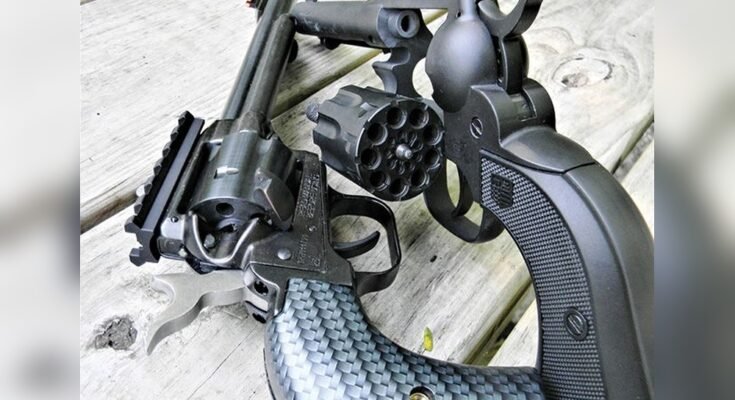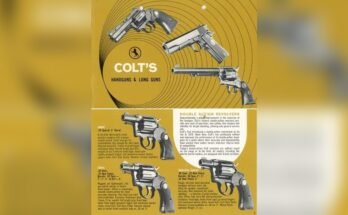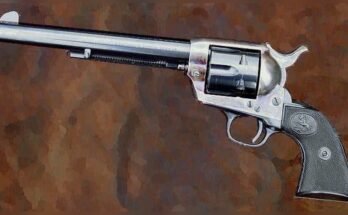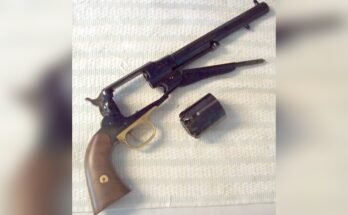If you’re interested in revolvers, understanding the difference between fixed cylinder and swing-out cylinder models is key. Knowing how each type works can help you choose the right one for your needs, whether it’s for sport, self-defense, or collection.
This isn’t just about mechanics—it’s about how quickly you can reload, how reliable your revolver feels, and how comfortable it is to handle. Keep reading, and you’ll discover the crucial details that can make a real difference in your shooting experience.
Fixed Cylinder Revolvers
Fixed cylinder revolvers represent one of the oldest designs in handgun history. They have a simple and sturdy build. This type of revolver keeps the cylinder attached firmly to the frame. The cylinder does not move or swing out for loading.
Understanding fixed cylinder revolvers helps in appreciating their unique qualities. Their design affects how users load, shoot, and maintain these guns. Many shooters value these revolvers for their reliability and classic style.
Design Features
The cylinder is solidly fixed to the revolver’s frame. It rotates to align each chamber with the barrel. The frame often has a loading gate on the side. This gate allows access to the chambers one at a time. The overall design is compact and strong. The lack of moving parts in the cylinder adds durability.
Loading And Unloading Process
Loading happens through a small gate on the revolver’s side. The shooter opens the gate to access one chamber at a time. Each round is inserted manually into the cylinder. To unload, the shooter uses an ejector rod. The rod pushes out each spent cartridge one by one. This process is slower than other revolver types. It requires patience and careful handling.
Advantages And Limitations
Fixed cylinder revolvers are very reliable and easy to maintain. Their solid design reduces the chance of mechanical failure. They can handle powerful cartridges safely. The main limitation is slow reloading. Speed loaders or moon clips cannot be used easily. This makes them less practical for quick shooting. Still, many appreciate their classic look and toughness.
Swing-out Cylinder Revolvers
Swing-out cylinder revolvers offer a modern take on revolver design. They provide easier access to the cylinder for faster reloading. This design improved handling and convenience for shooters.
These revolvers feature a cylinder that swings out to the side. This simple motion allows quick removal and insertion of cartridges. The design suits both casual shooters and professionals.
Design Features
The cylinder is attached on one side by a crane or yoke. It swings out to the left side of the revolver frame. This exposes all chambers at once for quick access. A latch or release mechanism holds the cylinder in place. It locks during firing for safety and stability. The frame often includes an ejector rod to push out spent cases.
Loading And Unloading Process
To load, press the release latch and swing the cylinder out. Remove empty cases by pushing the ejector rod. Insert fresh cartridges into the chambers. Swing the cylinder back into the frame until it clicks. This locks the cylinder securely in place. The process is fast and simple, saving time during shooting sessions.
Advantages And Limitations
Swing-out cylinders speed up reloading compared to fixed cylinders. They allow better cleaning access and visual checks of rounds. The design also provides smoother operation and better balance.
On the downside, swing-out cylinders add some weight and complexity. The moving parts may require more maintenance. They may not fit certain holsters built for fixed-cylinder models. Still, many shooters prefer them for their convenience and efficiency.
Performance Comparison
Comparing the performance of fixed cylinder and swing-out cylinder revolvers reveals key differences. These differences affect how each type operates in real situations. Understanding them helps choose the right revolver for your needs. Performance depends on speed, efficiency, durability, and maintenance.
Speed And Efficiency
Swing-out cylinder revolvers allow faster reloading. The cylinder swings out to the side, letting you remove and insert cartridges quickly. This design saves time during shooting sessions.
Fixed cylinder revolvers require manual removal of each spent cartridge. Reloading takes longer and can slow you down. However, fixed cylinders are simpler, with fewer moving parts.
Durability And Maintenance
Fixed cylinder revolvers are very durable. Their solid frame means fewer parts can break or wear out. This makes them reliable in tough conditions.
Swing-out cylinder revolvers have more moving parts. These parts need regular cleaning and care. Without proper maintenance, they may wear faster or cause malfunctions.
Both types need care, but fixed cylinders often require less upkeep. This suits users who want a low-maintenance option.

Practical Uses
Understanding the practical uses of fixed cylinder and swing-out cylinder revolvers helps choose the right type. Each design offers benefits suited to different needs. Knowing these uses aids in making smart decisions for ownership or use.
Self-defense And Law Enforcement
Swing-out cylinder revolvers are common in self-defense and law enforcement. Their quick reloading saves time during critical moments. Officers rely on the ability to reload fast under pressure. Fixed cylinder revolvers reload slower, which can be a drawback in urgent situations. Still, some prefer fixed cylinders for their simple and sturdy design. These revolvers often handle rough conditions well. They are also easier to maintain, which suits daily use by law enforcement.
Recreational Shooting And Collecting
Fixed cylinder revolvers have a special place in recreational shooting and collecting. Their traditional design appeals to collectors and enthusiasts. These revolvers offer a classic shooting experience. Many enjoy the slower, deliberate pace of shooting with fixed cylinders. Swing-out cylinder revolvers attract shooters who want faster reloads during target practice. Both types provide fun and challenge at the range. Collectors often seek fixed cylinder models for their history and craftsmanship.
Choosing The Right Revolver
Choosing the right revolver depends on many factors. Each type of revolver offers unique benefits and challenges. Understanding these helps in making a better choice. The fixed cylinder and swing-out cylinder revolvers differ mainly in how you load and unload them. This affects speed, ease, and safety during use. Below are key points to consider based on your needs and situations.
User Preferences
User comfort plays a big role in revolver choice. Fixed cylinder revolvers are simpler and usually lighter. They suit those who prefer basic, reliable designs. Swing-out cylinder revolvers allow quicker reloading. Users who value speed and efficiency may prefer these. Grip style, weight, and balance also affect comfort. Handling each type before buying is helpful. Personal taste and shooting style guide the decision.
Situational Considerations
Think about where and how you will use the revolver. Fixed cylinder revolvers work well for casual or backup use. Their simple design means fewer parts to fail. Swing-out cylinder revolvers are better for situations needing fast reloads. Law enforcement and sport shooters often choose these. Consider the environment, reload speed, and ammo capacity. Each factor influences which revolver fits best. Safety and ease of use matter most in any situation.

Frequently Asked Questions
What Is A Fixed Cylinder Revolver?
A fixed cylinder revolver has a non-movable cylinder. You load and unload bullets by removing the cylinder or manually ejecting shells. This design is simpler but slower for reloading compared to swing-out cylinders.
How Does A Swing-out Cylinder Revolver Work?
A swing-out cylinder revolver features a cylinder that swings out sideways. This allows quick access to all chambers for faster reloading. It improves reload speed and convenience over fixed cylinder models.
Which Revolver Type Reloads Faster?
Swing-out cylinder revolvers reload faster. Their design allows the cylinder to swing out, enabling quicker ejection and reloading of cartridges. Fixed cylinder revolvers require manual shell removal, making reloads slower.
Are Fixed Cylinder Revolvers More Durable?
Fixed cylinder revolvers are often more durable due to fewer moving parts. Their solid, immovable cylinder design reduces mechanical complexity and potential wear, enhancing long-term reliability.
Conclusion
Fixed cylinder and swing-out cylinder revolvers each have clear benefits. Fixed cylinders are simple and strong, with fewer moving parts. Swing-out cylinders offer faster reloading and easier access to chambers. Choosing depends on what matters most: speed or durability. Both types remain popular among shooters.
Understanding their differences helps you pick the right revolver. Think about your needs before deciding. This knowledge makes handling and maintenance easier too.



